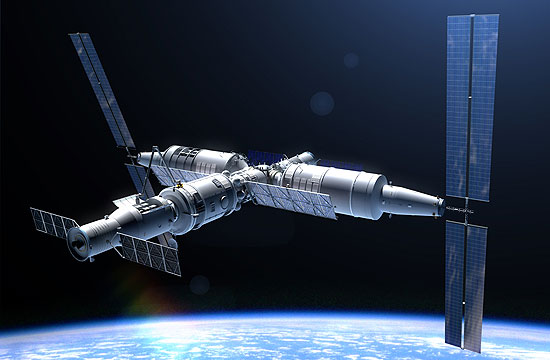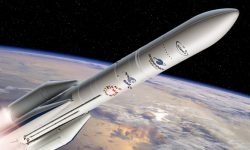
Tiangong 3 is dependent on the resumption of launches of the rocket Long March 5
– News of July 23, 2019 –
The Tiangong 2 space station has just been consumed in the Earth’s atmosphere, which was planned. For China, this marks the beginning of a period without a space station. Tiangong 1 and Tiangong 2 were essentially test phases before the launch of a real permanent and modular station, called Tiangong 3. Unfortunately, its development is a little late.
The new space station will consist of three modules of 22 tons each. Only one launcher has the capacity to put them into orbit, the Long March 5B. But following a failure in July 2017, this launcher is currently grounded, which paralyzes the project of a new space station and a whole section of the Chinese exploration program.
At this pace, the first module of Tiangong 3 will not be launched before 2020. It will then take two to three years for the CNSA to assemble the space station Tiangong 3 in Earth orbit. Once completed, it will allow China to have a permanent crew in space, a bit like the International Space Station.
In addition to these two scientific laboratories, the Chinese space station Tiangong 3 will also serve as a repair shop. China wants to launch a large optical telescope in a similar orbit, which will be able to dock with the space station for its maintenance and for its provisioning.
China may open Tiangong 3 to international astronauts. By the mid-2020s, there could therefore be more than 10 people in orbit at the same time when the International Space Station and the Chinese station will conduct crew relays. Before we get there, we are still waiting for a date for the next launch of the rocket Long March 5. Its delay will almost certainly shift the Chang’e 5 mission, which aims to collect and return lunar samples to Earth.

Tiangong 3, a Sino-Russian space station ?
– News of July 4, 2017 –
The Tiangong 3 space station project is scheduled to begin in 2018, which is part of China’s ambitious space program. To support the installation of this station, Beijing has implemented an entire ecosystem, including the Long March 7 rocket, the Tianzhou cargo spaceship and the Shenzhou capsule, which has now largely proved its worth.
Beijing seems to want to work with potential partners. This is particularly the case with Russia, which confirmed at the Paris Air Show that it has been approached by China to participate in this program. This proposal is likely to tempt Moscow because the International Space Station (ISS) is nearing the end of its life, and relations between Russia and its Western partners are deteriorating. This would be a new direction for the Russian space program. China also hopes to collaborate on this project with many countries that can not yet benefit from a space program, even though the initiative is probably primarily political. This should democratize access to space for small nations.
We learned a little more about the architecture of Tiangong 3. The central module called Tian He will be the first to be launched, from next year. It will serve as a place of life and work. Two scientific laboratories of about fifteen meters each will then be grafted to the station to form a pressurized volume of about 25% of that of the ISS. Once finalized, Tiangong 3 will be able to accommodate three Tikonauts for long-term stays in orbit. In addition to the space station, a Hubble-like telescope will be launched into a similar orbit and it should be able to dock at the station for ease of maintenance. Equipped with a two-meter main mirror and a field of view 300 times greater than Hubble, the space telescope focuses the hopes of Chinese astronomers. Beijing hopes to spread the construction of the Tiangong 3 Space Station over just four years. It would be complete in 2022. As the International Space Station is theoretically to retire in 2024, Beijing could end up with exclusive access to manned space flights.
Image by Bisbos









